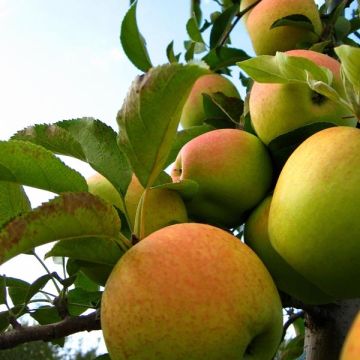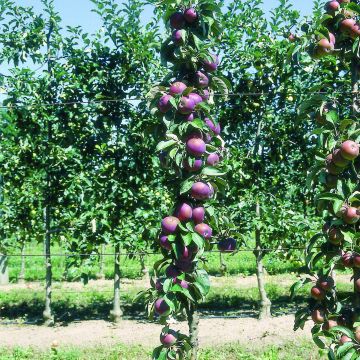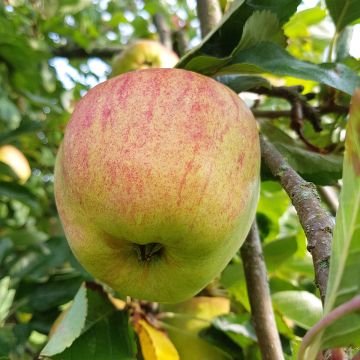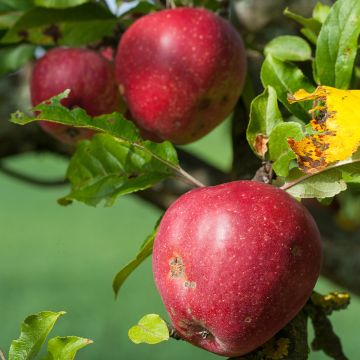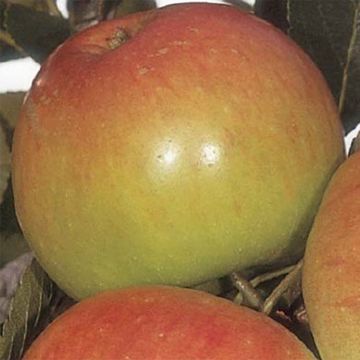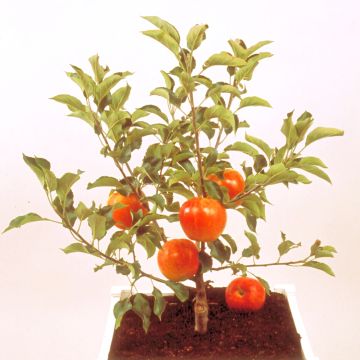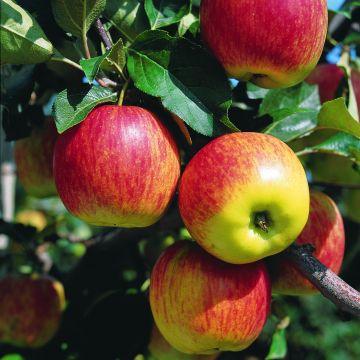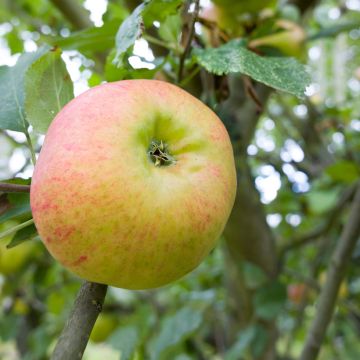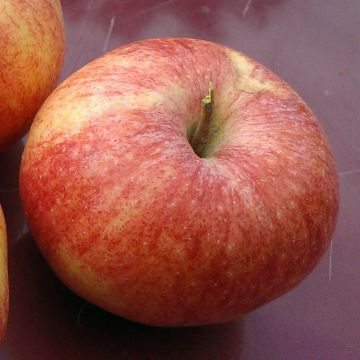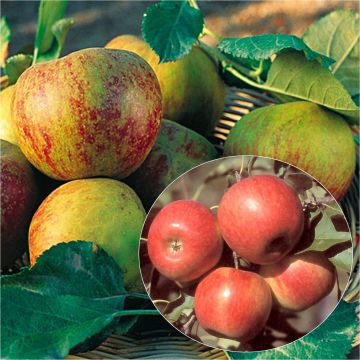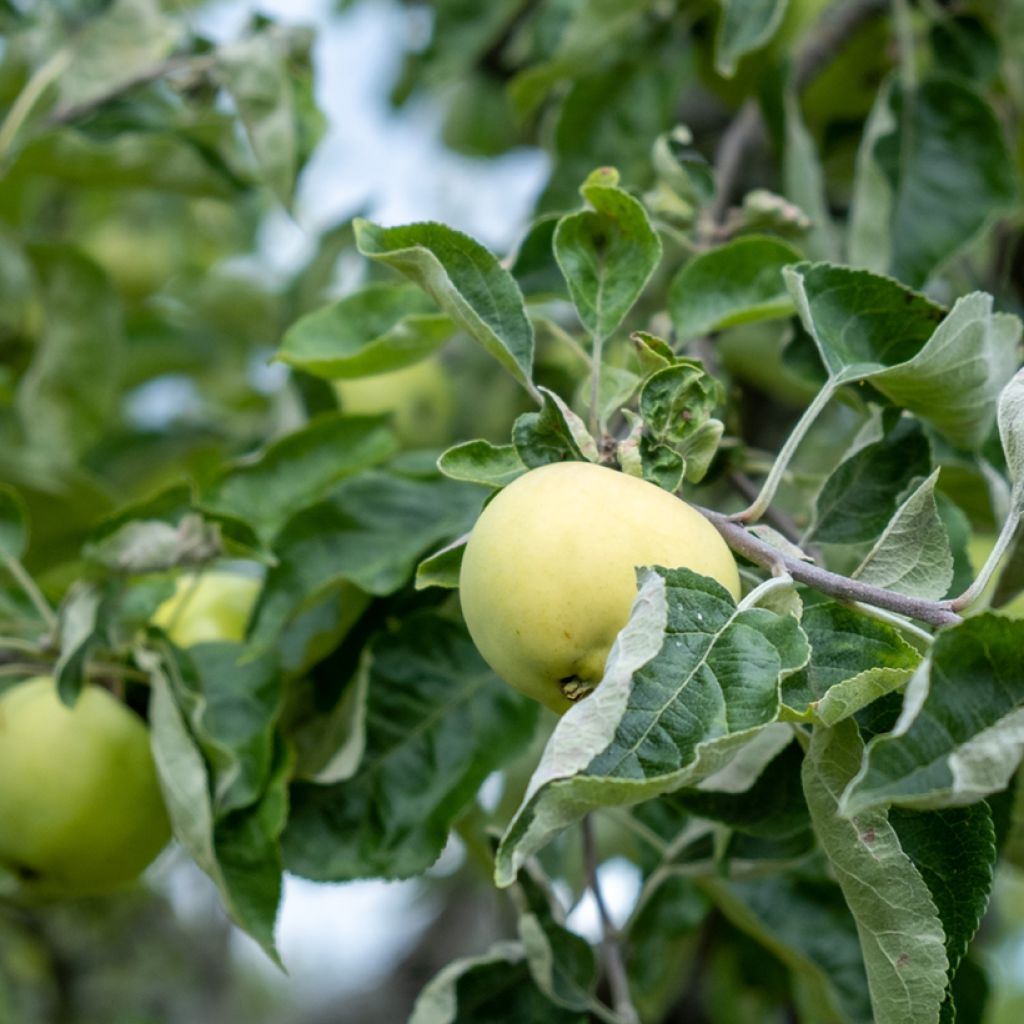

Apple Tree Antonówka Półtorapoundowa - Malus domestica
Apple Tree Antonówka Półtorapoundowa - Malus domestica
Malus domestica Antonówka Półtorapoundowa
Apple, Orchard apple, Table apple, Cultivated apple
This item cannot be shipped to the selected country
Oversize package delivery charge from €6.90
More information
Schedule delivery date,
and select date in basket
This plant carries a 6 months recovery warranty
More information
We guarantee the quality of our plants for a full growing cycle, and will replace at our expense any plant that fails to recover under normal climatic and planting conditions.
Oversize package: home delivery by special carrier from €6.90 per order..
Express home delivery from €8.90.
Description
The Antonovka Półtorapoundowa Apple Tree is an old variety from Russia, which explains its very good hardiness. The medium-sized tree produces a beautiful spring flowering that contrasts nicely with the foliage. This summer variety produces very large yellowish-green fruits towards the end of August, or even a little earlier, which can be eaten raw or cooked in desserts. Their fine and juicy flesh is also perfect for making delicious juices. Highly resistant to diseases, this self-sterile Apple Tree requires the presence of another variety for pollination and therefore fruit set.
The Apple Tree is an important member of the large Rosaceae family, which also includes most of our other fruit trees (Apricot Tree, Plum Tree, Raspberry Bush...). It also includes many wild species from our forests and countryside, as well as many ornamental plants (Cotoneaster, Physocarpus...). The genus Malus is rich in about forty species, both fruit-bearing like the Common Apple Tree or Malus domestica (synonyms, Malus communis or Malus pumila) and also flowering species, such as the sculptural Malus 'Appletini'. Cultivated since Roman times, there are now around 20,000 cultivars worldwide.
The Malus 'Antonovka Półtorapoundowa' is a Russian variety discovered in 1988 by the agronomist and nurseryman Ivan Michurin. The medium-sized tree can reach 3 to 4 meters in height and forms a wide, spherical crown, made up of upright, slender shoots. Similar to the Antonovka Zwykła variety, it differs in its larger, dark green elliptical leaves with dentate edges. Its fruits are also larger and ripen faster in summer. It also has a relatively early fruiting period, starting 2 to 3 years after planting. In April-May, the tree produces a charming flowering consisting of small single flowers in pinkish white. Gathered in umbels, they attract numerous pollinating insects and thus promote biodiversity in the garden. In this self-sterile tree, the flowers cannot self-pollinate, so another cultivar must be planted nearby to act as a pollinator. The most well-known for this role are 'Antonovka Zwykła' and 'Olive Jaune'. Once pollinated, the flowers develop into very large fruits of 7-8 cm in diameter and weighing up to 600 grams. Yellowish-green in color, they ripen in mid-August. The white flesh is fine, very juicy, and has a pleasant slightly acidic taste. A dessert apple, it is delicious eaten raw at the foot of the tree, and is equally suitable for making juices, desserts, or compotes. However, it should be consumed quickly, as it does not store well and is not very tolerant to transportation. The harvest is often abundant, but the variety tends to alternate, meaning a year of heavy harvest is often followed by a lean year as the tree replenishes its reserves (fruiting is an energy-intensive process in plants...).
Easy to grow in slightly moist soil, very cold-resistant, this Apple Tree is not susceptible to powdery mildew or scab. It will delight fans of large fruits, and its moderate growth allows it to find a place even in a garden with limited space. To vary the pleasures and harvest times, plant it alongside small fruits like the Redcurrant 'Jonkheer van Tets', whose small acidic red fruits will delight you from June. With a Cherry Tree 'Bigarreau Burlat', you can even start enjoying your harvest from June. And to extend the fruit season into autumn, consider the Common Medlar 'Westerveld', whose curious fruits are harvested after the first frosts, or the Persimmon, which offers its superb yellow-orange fruits until December.
Report an error about the product description
Plant habit
Fruit
Flowering
Foliage
Botanical data
Malus
domestica
Antonówka Półtorapoundowa
Rosaceae
Apple, Orchard apple, Table apple, Cultivated apple
Cultivar or hybrid
Other Apple trees
Planting and care
Choose a sunny spot for your Antonówka Półtorapoundowa Apple Tree, the soil can be slightly chalky or acidic, but not excessively so. Dig a wide planting hole at least three times the volume of the root ball. Simultaneously add organic matter (topsoil, compost...) and a base fertilizer such as crushed horn. Do not bury the graft collar. Stake if necessary. For apple trees planted in isolation and exposed to the wind, it may be beneficial to stake them by installing a bracing system: plant 3 stakes in a triangle 50 cm around the trunk, connect them with pieces of wood. Protect the bark with a piece of rubber, for example, and attach the stakes to the trunk with metal wires. Water generously, even in winter, even if it rains. Fruit trees are ideally planted between October and March, avoiding frost periods. Container-grown plants can be planted throughout the year except during periods of extreme heat or frost.
In winter, at the base of the tree and slightly incorporated into the soil surface, you can add a small shovelful of wood ash, rich in potash, to improve fruiting. The Apple Tree can be susceptible to various diseases and pests. To reduce risks, space the trees sufficiently, plant multi-species hedges, birdhouses, or insect hotels to attract beneficial insects. In summary: favour diversity. The main diseases of the Apple Tree are scab (brown spots on the leaves), brown rot (drying of flowers and fruit rot on the tree), and powdery mildew (white felt on the leaves). For these three cases, preventive action is recommended by spraying a horsetail decoction; as a last resort and in case of severe attacks, a curative treatment with Bordeaux mixture can be applied. Fortunately, you will have little to treat because this variety is very resistant to scab and powdery mildew.
As for pests, the codling moth (or fruit worm) is a small caterpillar, resulting from the laying of a butterfly, which creates galleries inside the fruit. To remedy this, it is preferable to act preventively by promoting the presence of tits and bats through the installation of nest boxes. In case of aphid infestation, spray a solution based on black soap.
During the harvest in August-September, consume the fruits quickly as they do not keep well over time. You can also make very good juices from them.
Planting period
Intended location
Care
This item has not been reviewed yet - be the first to leave a review about it.
Haven't found what you were looking for?
Hardiness is the lowest winter temperature a plant can endure without suffering serious damage or even dying. However, hardiness is affected by location (a sheltered area, such as a patio), protection (winter cover) and soil type (hardiness is improved by well-drained soil).

Photo Sharing Terms & Conditions
In order to encourage gardeners to interact and share their experiences, Promesse de fleurs offers various media enabling content to be uploaded onto its Site - in particular via the ‘Photo sharing’ module.
The User agrees to refrain from:
- Posting any content that is illegal, prejudicial, insulting, racist, inciteful to hatred, revisionist, contrary to public decency, that infringes on privacy or on the privacy rights of third parties, in particular the publicity rights of persons and goods, intellectual property rights, or the right to privacy.
- Submitting content on behalf of a third party;
- Impersonate the identity of a third party and/or publish any personal information about a third party;
In general, the User undertakes to refrain from any unethical behaviour.
All Content (in particular text, comments, files, images, photos, videos, creative works, etc.), which may be subject to property or intellectual property rights, image or other private rights, shall remain the property of the User, subject to the limited rights granted by the terms of the licence granted by Promesse de fleurs as stated below. Users are at liberty to publish or not to publish such Content on the Site, notably via the ‘Photo Sharing’ facility, and accept that this Content shall be made public and freely accessible, notably on the Internet.
Users further acknowledge, undertake to have ,and guarantee that they hold all necessary rights and permissions to publish such material on the Site, in particular with regard to the legislation in force pertaining to any privacy, property, intellectual property, image, or contractual rights, or rights of any other nature. By publishing such Content on the Site, Users acknowledge accepting full liability as publishers of the Content within the meaning of the law, and grant Promesse de fleurs, free of charge, an inclusive, worldwide licence for the said Content for the entire duration of its publication, including all reproduction, representation, up/downloading, displaying, performing, transmission, and storage rights.
Users also grant permission for their name to be linked to the Content and accept that this link may not always be made available.
By engaging in posting material, Users consent to their Content becoming automatically accessible on the Internet, in particular on other sites and/or blogs and/or web pages of the Promesse de fleurs site, including in particular social pages and the Promesse de fleurs catalogue.
Users may secure the removal of entrusted content free of charge by issuing a simple request via our contact form.
The flowering period indicated on our website applies to countries and regions located in USDA zone 8 (France, the United Kingdom, Ireland, the Netherlands, etc.)
It will vary according to where you live:
- In zones 9 to 10 (Italy, Spain, Greece, etc.), flowering will occur about 2 to 4 weeks earlier.
- In zones 6 to 7 (Germany, Poland, Slovenia, and lower mountainous regions), flowering will be delayed by 2 to 3 weeks.
- In zone 5 (Central Europe, Scandinavia), blooming will be delayed by 3 to 5 weeks.
In temperate climates, pruning of spring-flowering shrubs (forsythia, spireas, etc.) should be done just after flowering.
Pruning of summer-flowering shrubs (Indian Lilac, Perovskia, etc.) can be done in winter or spring.
In cold regions as well as with frost-sensitive plants, avoid pruning too early when severe frosts may still occur.
The planting period indicated on our website applies to countries and regions located in USDA zone 8 (France, United Kingdom, Ireland, Netherlands).
It will vary according to where you live:
- In Mediterranean zones (Marseille, Madrid, Milan, etc.), autumn and winter are the best planting periods.
- In continental zones (Strasbourg, Munich, Vienna, etc.), delay planting by 2 to 3 weeks in spring and bring it forward by 2 to 4 weeks in autumn.
- In mountainous regions (the Alps, Pyrenees, Carpathians, etc.), it is best to plant in late spring (May-June) or late summer (August-September).
The harvesting period indicated on our website applies to countries and regions in USDA zone 8 (France, England, Ireland, the Netherlands).
In colder areas (Scandinavia, Poland, Austria...) fruit and vegetable harvests are likely to be delayed by 3-4 weeks.
In warmer areas (Italy, Spain, Greece, etc.), harvesting will probably take place earlier, depending on weather conditions.
The sowing periods indicated on our website apply to countries and regions within USDA Zone 8 (France, UK, Ireland, Netherlands).
In colder areas (Scandinavia, Poland, Austria...), delay any outdoor sowing by 3-4 weeks, or sow under glass.
In warmer climes (Italy, Spain, Greece, etc.), bring outdoor sowing forward by a few weeks.

































